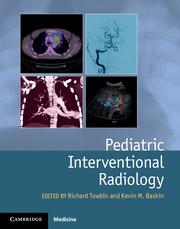6 - Genitourinary interventions
Published online by Cambridge University Press: 05 June 2015
Summary
History
Minimally invasive techniques are well suited for use in the child's urinary tract. As a result, the urinary tract was one of the initial systems to be treated using a percutaneous approach. In spite of the numerous percutaneous procedures that are currently available to diagnose and treat problems involving the urinary tract, it is this area of interventional practice that has grown the least in the past decade. The relatively limited involvement by interventional radiologists is likely due to a variety of factors including the preference of urologists to perform combined percutaneous and surgical procedures in the operating room.
As is the case in other systems, interventional procedures in the genitourinary system result in less pain, shorter hospital stays, and faster recovery than open surgical alternatives. In addition, in most hospitals there is a shorter time between request for and performance of the procedure with lower cost than open surgery. Despite these factors, referrals to the interventional service favor children with failed surgical procedures, after-hours procedures, or other difficult cases. A willingness to help with these cases often leads in time to more frequent referral of the many children who could benefit from image-guided therapy that are not currently being seen by the pediatric interventionalist for routine procedures.
Anatomic considerations
To successfully perform genitourinary procedures a fundamental understanding of the anatomy of the kidneys, including the peculiarities of renal vascular and morphologic anomalies and post-transplant relationships, is essential to maximize desirable outcomes while avoiding complications. While a complete review is beyond the scope of this text, the reader is encouraged to seek out some of the excellent texts and monographs that focus on this material.
With their long axis aligned with the psoas muscles, the kidneys are normally located between T12 and L2 to L3, although with ectopia they may be positioned anywhere between the thorax and the pelvis in the retroperitoneum. Their lateral borders are normally rotated 30 degrees posterior to the frontal plane. Kidneys may be malrotated, fused (horseshoe kidney), duplicated, ectopic (crossed-fused renal ectopia), dysplastic, or unilaterally absent (agenesis).
- Type
- Chapter
- Information
- Pediatric Interventional Radiology , pp. 297 - 355Publisher: Cambridge University PressPrint publication year: 2015



